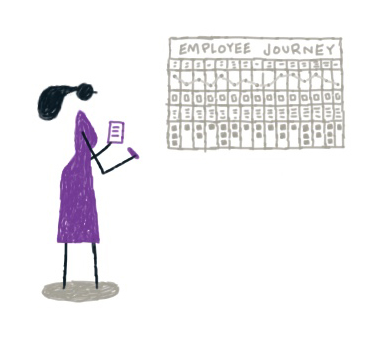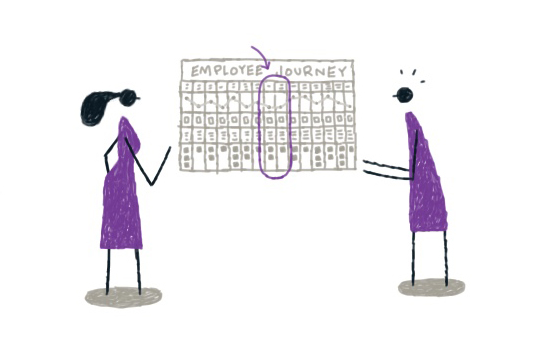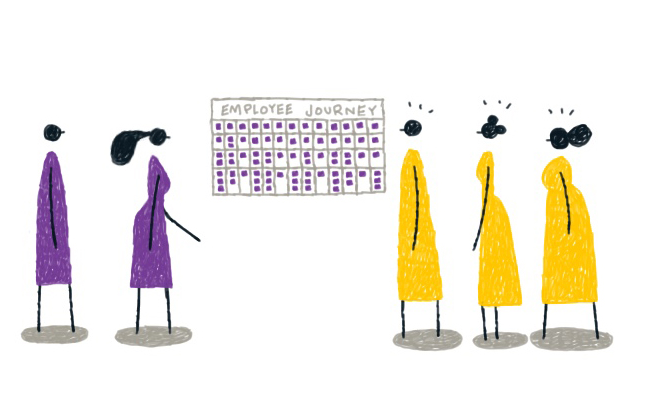Understand Employees and Move Critical Initiatives Forward With This One Tool
by Vittoria Tedaldi
December 4, 2020

No matter how intuitive and in touch you are as a leader, there will inevitably be times employee insights are just out of reach. Unearth those valuable perspectives with the Employee Experience Journey Map. You’ll amass critical information and—bonus—discover ways to move forward with your most pressing initiatives.
Welcome to the second post in our series about the Employee Experience Journey Map—a handy diagnostic tool that can capture a snapshot of employee experience in your organization.
This tool is a great way to organize ideas and work as a team around a common structure. (Read our first post in the series, Eight Steps to Improving Employee Experience, to learn more about the importance of this tool.)
While journey maps are useful didactic tools, they are merely a means to an end—not an end in themselves.
To get the most from these tools, you need to do more than simply “tick the boxes.” You must connect the framework to your objectives (e.g. you’d like to improve your company’s onboarding process, or maybe you’re trying to ascertain how employees are adjusting to new technology tools that have been implemented, etc.).
So let’s test the flexibility of the Employee Experience Journey Map by exploring how to use it in a research process.
Step 1: Collect Information and Determine Key Objectives

Before you start any employee-related change initiative, keep in mind that you’ll want to collect information from the employee’s perspective. Use the Employee Experience Journey Map as a basis for your conversations.
The journey map asks you to explore questions such as, What do we know? What do we need to look at in depth? What should we prioritize?
By answering these questions and more, you’ll be able to identify areas for improvement and get a better sense of crucial insights you’ll want to explore such as:
- your vision about the employee experience the employee perspective of their experience
- employee pain points
- opportunities
- different phases of work, including priorities
- processes in progress
- touchpoints
The journey map will also help you identify beliefs and assumptions that can later be more closely examined during the investigation.
By designing your research with your client (e.g., HR manager), honing in on insights, beliefs, and assumptions to explore, you’ll be able to more easily prepare guidelines for in-depth interviews with employees. You’ll also ensure that you collect meaningful information on employee journey moments critical to your study.
Step 2: Gather Employee Perspectives

Playing with the map’s timeline during your research can help you obtain rich, detailed information related to the social and emotional context of each employee.
As you’re gathering information from employees, here are some ways in which you can better understand their ways of working:
- Focus on specific moments: What is the experience of the person who starts working in the company, who works from home, or who has a baby? What does a day look like in the life of an employee who has been at the organization for years and thinks they have no possibility for promotion?
- Travel in time, looking back and ahead: How is a new employee experiencing onboarding? What does the veteran employee remember about beginning at the company? How are their experiences similar? How are they different? What are their expectations regarding their future in the organization, and why?
Use the Employee Journey map—zooming in on aspects you consider necessary—to stimulate and enrich your research sessions with employees. Capture their thoughts and emotions in depth.
- Pro tip: Ask participants to associate images or drawings with different stages on their journey map—this will visually allow you to see the emotions and feelings employees have along different stages of their journey—or have them construct conceptual prototypes for possible points of contact. The visual possibilities to capture their feedback are infinite.
Step 3: Organize and Analyze Findings

Now that you’ve interviewed employees, you’ll want to take time to organize, analyze, and clarify your collected data.
You can next use the Employee Experience Journey Map as a guide to presenting lessons learned to your team. “Break” it and “reconstruct” it as needed to fit your context and the needs of the people (e.g., HR manager) who will use the research to improve the employee experience.
Key milestones on the map may change, new categories of information will emerge, and others will disappear.
You may also need to highlight a specific moment, which will call for generating a map within a map that zooms in on a specific stage of the process.
Step 4: Compare Findings

Even if the paper it’s drawn on is crumpled or it’s been tucked away in a file, pull out the map you initially designed at the beginning of this process.
With your HR lead or with the individual leading your initiative, compare the original map to the newly constructed map based on your research findings.
Are there differences between the two? How do you account for the differences? What impact does it have on employee experience?
A Portal to Progress

By using your updated journey map—in its entirety or in sections—in a workshop setting, you can engage various parties in discussions about how to move forward.
You’ll find the time you took to authentically understand employee thoughts, ideas, beliefs, and assumptions a portal to real organizational progress.
If you found this post helpful, we recommend these additional resources:
- Eight Steps to Improving Employee Experience
- Rethinking the Future of Working, Together
- How to Evolve Your Culture (webinar recording)
If your company is interested in an employee experience change initiative, we’d love to chat! Contact us for more information.